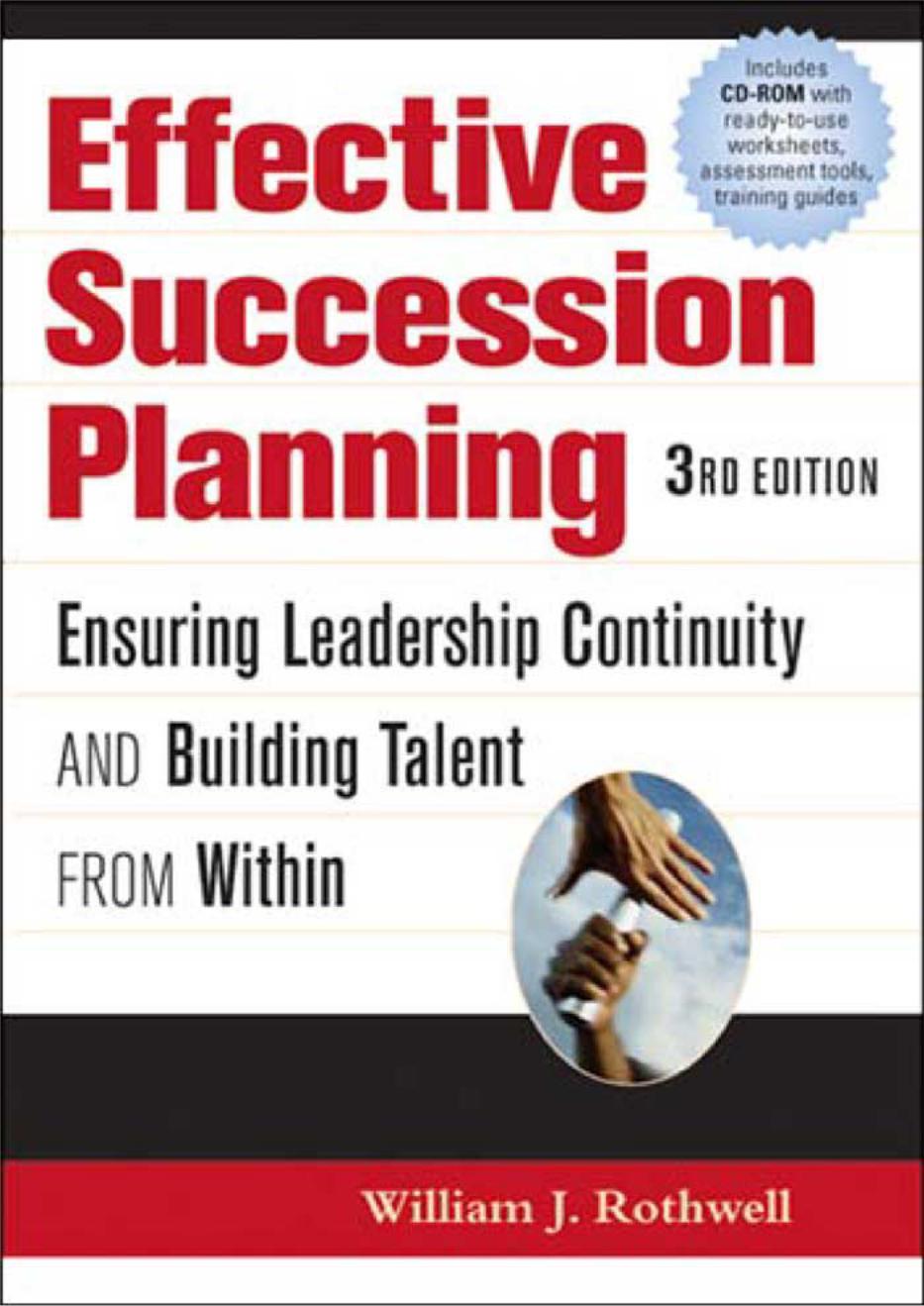
William J. Rothwell - Effective Succession Planning (2005)(3-e)(en)
.pdf

EFFECTIVE
SUCCESSION
PLANNING
T H I R D E D I T I O N
This page intentionally left blank

EFFECTIVE
SUCCESSION
PLANNING
T H I R D E D I T I O N
Ensuring Leadership Continuity and
Building Talent from Within
William J. Rothwell
American Management Association
New York • Atlanta • Brussels • Chicago • Mexico City • San Francisco
Shanghai • Tokyo • Toronto • Washington, D.C.

Special discounts on bulk quantities of AMACOM books are available to corporations, professional associations, and other organizations. For details, contact Special Sales Department, AMACOM, a division of American Management Association, 1601 Broadway, New York, NY 10019.
Tel.: 212-903-8316. Fax: 212-903-8083. Web site: www.amacombooks.org
This publication is designed to provide accurate and authoritative information in regard to the subject matter covered. It is sold with the understanding that the publisher is not engaged in rendering legal, accounting, or other professional service. If legal advice or other expert assistance is required, the services of a competent professional person should be sought.
Library of Congress Cataloging-in-Publication Data
Rothwell, William J.
Effective succession planning : ensuring leadership continuity and building talent from within / William J. Rothwell.— 3rd ed.
p. cm.
Includes bibliographical references and index. ISBN 0-8144-0842-7
1. Leadership. 2. Executive succession—United States. 3. Executive ability. 4. Organizational effectiveness. I. Title.
HD57.7.R689 2005 658.4 092—dc22
2004024908
2005 William J. Rothwell. All rights reserved.
Printed in the United States of America.
This publication may not be reproduced, stored in a retrieval system,
or transmitted in whole or in part,
in any form or by any means, electronic, mechanical, photocopying, recording, or otherwise, without the prior written permission of AMACOM, a division of American Management Association, 1601 Broadway, New York, NY 10019.
Printing number
10 9 8 7 6 5 4 3 2 1

TO MY WIFE MARCELINA, MY DAUGHTER CANDICE,
MY SON FROILAN, AND MY GRANDSON ADEN
This page intentionally left blank

C O N T E N T S
List of Exhibits |
xiii |
Preface to the Third Edition |
xvii |
Acknowledgments |
xxxi |
Advance Organizer for This Book |
1 |
PART I |
|
BACKGROUND INFORMATION ABOUT SUCCESSION |
|
PLANNING AND MANAGEMENT |
5 |
C H A P T E R 1 |
|
What Is Succession Planning and Management? |
7 |
Six Ministudies: Can You Solve These Succession Problems? |
7 |
Defining Succession Planning and Management |
10 |
Distinguishing Succession Planning and Management from |
|
Replacement Planning, Workforce Planning, Talent Management, |
|
and Human Capital Management |
16 |
Making the Business Case for Succession Planning and Management |
18 |
Reasons for a Succession Planning and Management Program |
20 |
Best Practices and Approaches |
30 |
Ensuring Leadership Continuity in Organizations |
35 |
Summary |
39 |
C H A P T E R 2 |
|
Trends Influencing Succession Planning and Management |
41 |
The Ten Key Trends |
42 |
What Does All This Mean for Succession Planning and Management? |
54 |
Summary |
55 |
vii

viii |
CONT ENT S |
|
|
C H A P T E R 3 |
|
Moving to a State-of-the-Art Approach |
56 |
Characteristics of Effective Programs |
56 |
The Life Cycle of Succession Planning and Management Programs: |
|
Five Generations |
59 |
Identifying and Solving Problems with Various Approaches |
69 |
Integrating Whole Systems Transformational Change and |
|
Appreciative Inquiry into Succession: What Are These Topics, |
|
and What Added Value Do They Bring? |
76 |
Requirements for a Fifth-Generation Approach |
78 |
Key Steps in a Fifth-Generation Approach |
78 |
Summary |
81 |
C H A P T E R 4 |
|
Competency Identification and Values Clarification: |
|
Keys to Succession Planning and Management |
82 |
What Are Competencies? |
82 |
How Are Competencies Used in Succession Planning and |
|
Management? |
83 |
Conducting Competency Identification Studies |
84 |
Using Competency Models |
85 |
New Developments in Competency Identification, Modeling, and |
|
Assessment |
85 |
Identifying and Using Generic and Culture-Specific Competency |
|
Development Strategies to Build Bench Strength |
86 |
What Are Values, and What Is Values Clarification? |
87 |
How Are Values Used in Succession Planning and Management? |
89 |
Conducting Values Clarification Studies |
90 |
Using Values Clarification |
91 |
Bringing It All Together: Competencies and Values |
91 |
Summary |
91 |
PART II |
|
|
|
LAYING THE FOUNDATION FOR A SUCCESSION |
|
PLANNING AND MANAGEMENT PROGRAM |
93 |
C H A P T E R 5 |
|
Making the Case for Major Change |
95 |
Assessing Current Problems and Practices |
95 |
Demonstrating the Need |
101 |
Determining Organizational Requirements |
108 |

Contents ix
Linking Succession Planning and Management Activities to |
|
Organizational and Human Resource Strategy |
108 |
Benchmarking Best Practices and Common Business Practices in |
|
Other Organizations |
113 |
Obtaining and Building Management Commitment |
114 |
The Key Role of the CEO in the Succession Effort |
120 |
Summary |
124 |
C H A P T E R 6 |
|
Starting a Systematic Program |
125 |
Conducting a Risk Analysis and Building a Commitment to Change |
125 |
Clarifying Program Roles |
126 |
Formulating a Mission Statement |
130 |
Writing Policy and Procedures |
136 |
Identifying Target Groups |
138 |
Clarifying the Roles of the CEO, Senior Managers, and Others |
142 |
Setting Program Priorities |
143 |
Addressing the Legal Framework |
145 |
Establishing Strategies for Rolling Out the Program |
147 |
Summary |
155 |
C H A P T E R 7 |
|
Refining the Program |
156 |
Preparing a Program Action Plan |
156 |
Communicating the Action Plan |
157 |
Conducting Succession Planning and Management Meetings |
160 |
Training on Succession Planning and Management |
164 |
Counseling Managers About Succession Planning Problems in Their |
|
Areas |
172 |
Summary |
174 |
PART III |
|
|
|
ASSESSING THE PRESENT AND THE FUTURE |
177 |
C H A P T E R 8 |
|
Assessing Present Work Requirements and Individual Job |
|
Performance |
179 |
Identifying Key Positions |
180 |
Three Approaches to Determining Work Requirements in Key |
|
Positions |
184 |
Using Full-Circle, Multirater Assessments |
189 |
